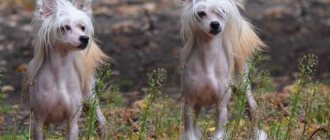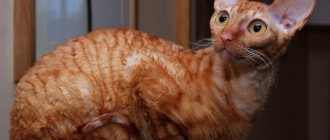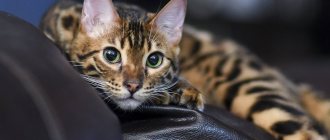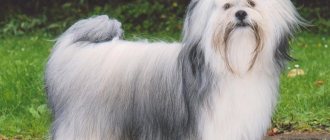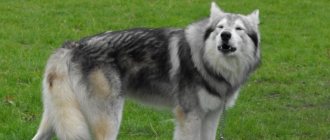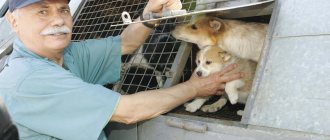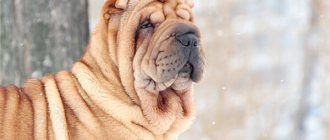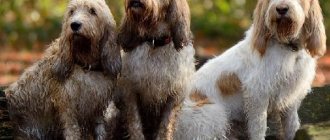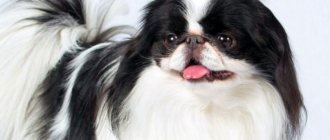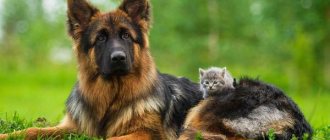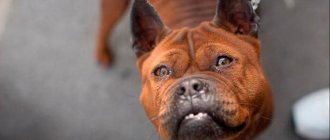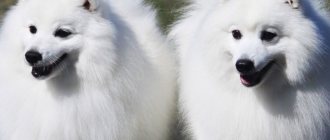Some dog breeds are so distinctive in appearance that they are difficult to confuse with others. One of them is the Chinese Crested Dog. There was a time when its representatives almost disappeared, but thanks to the efforts of lovers of small dogs with unusual external characteristics, it was preserved.
History of the Hairless Chinese Crested Dog breed
Chinese Crested Dog
Direct evidence that the Celestial Empire was the homeland of the Chinese Crested Dog has not yet been found. Yes, Asian nobles have always been greedy for live exotics and traditionally preferred small hairless dogs, but most of these pets were “foreigners” brought from other countries. If we talk specifically about CHS, modern researchers offer three relatively plausible versions of their origin. According to the first of them, miniature “crested dogs” are direct descendants of the extinct African hairless dog, which sailed to China with trade caravans. The second theory is based on the external similarity of the “Chinese” to the Mexican hairless dog. True, it is not entirely clear by what routes animals from the then unknown American continent made their way to Asia. The third possible homeland of Chinese hairless crested dogs is the territory of modern Thailand and Sri Lanka, whose inhabitants have had trade relations with China since time immemorial and, accordingly, had the opportunity to send their four-legged charges there.
The modern stage of the breed’s development occurred at the end of the 19th century, when New York journalist Ida Garrett brought the first “Chinese” to the United States. The woman was so delighted with the decorative “crested” birds that she devoted 60 years of her life to breeding them. At the beginning of the 20th century, professional breeders also became interested in pets. In particular, the American breeder Deborah Woods started the first stud book of Chinese Cresteds already in the 30s of the last century. In 1959, the first club of CHS fans appeared in the USA, and in 1965, one of Mrs. Woods’s charges set off to conquer Foggy Albion. British breeders also did not remain indifferent to exotic dogs, as evidenced by the opening of numerous nurseries in different parts of England between 1969 and 1975. At the same time, the red tape with recognition of the breed by canine associations dragged on for a long time. The KC (English Kennel Club) was the first to capitulate in 1981, and 6 years later the FCI joined in, approving the right of Chinese Cresteds to breed. The AKC (American Kennel Club) held on the longest, declaring the “Chinese” an independent breed only in 1991.
Hairless Chinese Crested Dog
Chinese Crested Powder Puff Dog
Appearance of a Chinese Crested Dog
Chinese Crested Dog Puppy
The Chinese Crested Dog is not the most easy-to-keep breed, but this disadvantage is fully compensated by the non-trivial image of its representatives. According to the standard approved by the FCI, Chinese Cresteds can have a fawn or stocky build. Individuals from the first category are distinguished by a lightweight skeleton (skeleton) and, accordingly, great grace. Stocky animals are almost twice as heavy as their counterparts (the weight of an adult dog can reach 5 kg) and are stockier.
Head
Slightly elongated, the skull is moderately rounded, the cheekbones are not prominent. The muzzle is slightly narrowed, the stop is moderately expressed.
Teeth and jaws
The jaws of Chinese Cresteds are strong, with a correct bite (the lower teeth are completely covered by the upper ones). In hairless individuals, molars often do not erupt, but such a deviation from the standard is considered quite acceptable, since it is genetically determined.
Nose
The lobe is of medium size, the color can be any.
Ears
Relatively large, set vertically. The exception to the rule is the downy-type Chinese Crested, which may have floppy ears.
Eyes
The KHS has small, wide-set and very dark eyes.
Neck
Dry, long, with a graceful curve, which is especially noticeable in a moving animal.
Muzzle of a Hairless Chinese Crested Dog
Frame
The body length of individuals of the deer and stocky types varies greatly. In the first case, the body will be of normal proportions, in the second - elongated in length. Representatives of the Chinese Crested breed have a wide chest, slightly curved ribs, and a tucked belly.
Limbs
The front legs of hairless Chinese Crested dogs are straight and thin. The shoulders are narrow and “look” back, and the pasterns are miniature and stand almost vertically. The hindquarters are level, with muscular thighs and low hocks. The paws of Chinese crested cats are of the hare type, that is, narrow and elongated in length. The toes are covered with “boots” made of airy wool.
Tail
Naked Crested and Powder Puff
Long, straight type, with a spectacular plume of soft wool. When moving it is kept raised, when at rest it is lowered.
Wool
Ideally, hairless cats should only have hair on their paws, tail and head, although there are frequent exceptions to the rule. Powder puffs are completely overgrown with soft veil-like hair, under which a small undercoat is hidden. At the same time, both hairless and downy dogs have a charming “forelock” on the head.
Color
In world cynology, all types of colors of Chinese crested dogs have been declared permitted. The inhabitants of Russian nurseries have only 20 officially recognized colors:
Hairless Chinese dog on display
- solid white;
- White black;
- white-blue;
- white chocolate;
- white-bronze;
- white-cream;
- solid black;
- black and white;
- black and tan;
- solid cream;
- creamy white;
- solid chocolate;
- solid bronze;
- bronze with white;
- sable;
- chocolate with white;
- chocolate and tan;
- solid blue;
- blue with white;
- tricolor.
Important: hairless, downy, fawn or stocky type - all these varieties of Chinese Cresteds have equal rights, so a dog can be disqualified at an exhibition only for its non-compliance with the breed standard, but not for external features.
Breed standards
| Classification FCI 288 | Group 9. Companions and lap dogs. Section 4. Hairless dogs. |
| Usage | Decorative companion dog |
| Appearance | A small, graceful dog with thin to medium bones. There are two varieties of the breed - hairless and downy, and two types: deer - thin-boned, and cobby - stocky and heavier. |
| Temperament, behavior | Cheerful, flexible, aggression is completely absent. |
| Head |
|
| Frame |
|
| Limbs |
|
| Movements | Long, elegant and flowing. |
| Wool | There should be no large areas of topcoat hair on the body. The crest is best flowing. |
| Color | Any. |
| Height | Height at withers:
|
| Flaws | Deviation from the above parameters is a disadvantage. |
Photo of Chinese Crested Dog
Personality of the Chinese Crested Dog
Chinese Crested Dog with a Beloved Owner
Sociable, friendly, adoring its owner - if your CHS does not have at least these three qualities, think about whether this is really a Chinese Crested dog. The breed's amazing attachment to humans has given rise to a number of myths about its mental talents. For example, many owners of “Chinese dogs” are seriously confident that their pets have a tendency towards telepathy and are able to predict desires.
There are also many stories about the so-called “medicinal value” of the breed. True, this applies more to “naked ones”, whose skin seems hot due to the lack of hair on it. According to the owners, hairless Chinese crested dogs alleviate pain from arthrosis and rheumatism, performing the function of a living heating pad. It is difficult to judge how true such stories are, but it is a proven fact that CHS really know how to create a harmonious, peaceful atmosphere in the house.
One of the main phobias of the Chinese Crested breed is loneliness. An animal left for a long time in an empty apartment literally goes crazy, notifying others of its misfortune with a loud howl. However, in order to bark from the heart, “puffs” and “chubs” do not always need a reason, so if at some point your pet gets carried away with “oratorios”, take care of his education. But don’t overdo it: you still won’t be able to turn a crested vocalist into a silent one.
Representatives of this breed are not tied to the sofa and are quite mobile. The back seat of a car, a bicycle basket or a regular leash - choose any method you like and feel free to take your pet out into the world. In addition, mischievous “tufts” are always happy to play with a ball, squeaker and other dog entertainment. Well, if any member of the household, including children, joins the process, the “Chinese”’s joy will know no bounds.
In CHS, love for a person often reaches the point of obsession. Puppies intuitively copy cat behavior: they rub against their legs, try to perch on their laps and play cuddles with their adoring owner. Trying to cultivate emotional coldness and sedateness in Chinese Cresteds is useless, and for the animal’s psyche it is also a deliberately harmful activity. If the prospect of constant close contact with your pet seriously stresses you out, you will have to opt for another, less sociable breed.
Breed characteristics
Males:
Bitches:
Price:
Lifespan: 11–14 years. |
Is it difficult to care for a Chinese Crested? | Difficulty of care is above average. With such physiological characteristics, dogs need special protection. They are afraid of atmospheric phenomena. And Chinese dogs are difficult to train. |
Is it suitable for inexperienced owners? | Not the best choice for inexperienced owners. Representatives of the breed show stubbornness during training for cleanliness. |
Where is it better for a pet to live: in a house or apartment? | The breed is suitable for any premises; it can live in both a small apartment and a large house. Keeping her in an enclosure is contraindicated. |
Does it show watchdog qualities? | A Chinese woman won't make a watchman. She has practically no guard instinct. |
What are the features of hair and skin care? | Puffballs require regular grooming and daily brushing. Skin care for hairless individuals consists of lubricating the surface with moisturizing creams, bathing and combing and trimming overgrown areas. |
Are there any problems with catering? | The breed is not picky about its diet. Both ready-made food and natural feeding are suitable. There are unusual taste preferences. |
Are there any difficulties with socialization? | The dog becomes strongly attached to its owner, loves to communicate with other people, but can be wary of strangers. |
Is it possible to leave a pet alone for a long time? | When alone, dogs may express fear by howling and whining. This behavior needs to be stopped. |
Who is the breed not suitable for? | Sedentary people, owners who are not willing to spend a lot of time on care, families with small children (this is a fragile dog that can be easily harmed). |
Can I buy for a child? | Chinese women love children very much, but they are not suitable for children to play with. |
Do you get sick often? | They may suffer from dental and eye diseases, and allergic reactions to the skin are possible. |
Do you need clothes? | Yes, these sissies need clothes. Moreover, naked individuals need it even in summer to protect against burns. |
Can it be kept with other animals? | As a rule, pets treat other animals well and can live side by side with cats. |
Advantages of the breed
- Loyalty and affection for the owner.
- Good adaptation to various conditions of detention.
- Mobility and curiosity.
- Attachment to people.
- Undemanding to walks, they do well in an apartment.
- Possibility of housing for elderly and disabled people.
- Skin devoid of vegetation does not allow fleas to settle.
- Excellent socialization.
- The ability to sense the owner's mood.
- Good health.
Flaws
- Eccentric appearance (representatives of this breed most often win the ugliest dog competition).
- Manifestations of self-centeredness in character.
- Can be stubborn during training.
- It is difficult to accustom to neatness and to wean from marking territory.
- Difficult to care for (requires a whole range of procedures).
- Need protection from cold and sun rays.
- There is a high risk of skin problems.
- Tendency to allergies to wool.
- Difficult birth.
Education and training
Training a Chinese Crested Dog
Often on zooforums you can find complaints about the narrow-mindedness and poor manners of the KHS, although in fact the “crested animals” are smart, inquisitive and quite trainable creatures. And yet, not a single dog, even the most intellectually developed one, will train itself, so if you expect an innate sense of tact and behavioral aristocracy from the animal, then it is completely in vain.
Raising a puppy begins at birth or from the first minutes of its appearance in the house. First, teach your baby to sit and don’t let him climb into your bed (yes, KHS are exceptional charmers, but they should sleep on their own bed). If the puppy misses his mother and brothers too much, at first a heating pad is placed on his mattress, creating the illusion of a warm dog’s belly. And don’t forget that the psyche of Chinese crested dogs is very fragile, so squeeze your own emotions into a fist and never yell at a child who has messed up.
Problems with the toilet, which breed owners often complain about, arise mainly in individuals who were poorly or too late explained how to use the equipment for canine needs. In general, Chinese Cresteds are born “diaper-eaters” and “hawkers”, that is, they cannot endure for long and prefer to do their “deeds” with a newspaper or in a tray rather than wait for a walk. However, it is quite possible to accustom them to the outdoor toilet, and the methods used are the same as for dogs of other breeds.
Despite the fact that, due to their slight build, KHS seem manageable and pliable, they still need to be trained. In particular, the command “No!” Every adult “Chinese” is obliged to understand and perform, just as he must approach the owner when he calls. If desired, the Chinese Crested can be taught simple circus tricks. It is known that “powder puffs” and “chubs” walk well on their hind legs and spin around to the music.
Hairless Chinese Crested Dog
Pros and cons of the breed
The crested dog looks like a little man, his hair is disheveled, his facial expression is kind and pretty - all this is not deceptive. If we look at the reviews about the breed, it is worth noting that many dog breeders consider the Chinese dog to be the kindest creature, a reliable friend and companion. Cheerful and friendly disposition, constant activity, predisposition to communicate not only with relatives and adults, but also with small children.
The crested cat quickly becomes attached to its owner. If he's gone for a long time, he starts to feel sad. Dogs do not like to be alone for long periods of time. Dogs do not hide their immense joy when their owner returns home. The meeting is accompanied by dancing, squeals, grunts, and licking. The pet tries with all its appearance and behavior, including to express love.
There are often cases when a dog grows up, and the owner for some reason is forced to part with him. Parting in this case is quite painful for the animal, since it is extremely difficult to get used to the new owner. The adaptation period takes several months. As practice shows, the Chinese Crested is capable of being sad as much as it is happy.
This breed has one feature that is considered a disadvantage - dogs love to dig holes. At the same time, they can dig holes in any place and time. They are just fanatics about digging holes. At the same time, their love for this activity is much more developed than among the same dachshunds. Thus, if you leave a dog in a garden plot unattended, then in a short period of time all the ground will be dug up. However, you can train your pet to dig holes in a place specially designed for this. A complete ban can have a negative impact on the animal’s psyche.
Maintenance and care
At home, your pet should feel comfortable and protected, so arrange a secluded corner for him. The best option is a small house, although a bed with sides is also suitable. A growing Chinese Crested dog should have a sufficient number of toys. Both rubber beepers from the store and alternative options like corks, balls and small cardboard boxes will work here. For trips to the veterinarian or travel, it is better to purchase a carrying bag.
Hygiene
Beautiful "puff"
Paradoxical as it may seem, there is no less fuss with the skin of the “nude” than with the fur of powder puffs. Wash hairless CHS once or even twice a week using a mild, hypoallergenic shampoo and conditioner. If you don’t have any special hygiene products at hand, you can limit yourself to baby or tar soap. Blow drying is also a must.
Blackheads and comedones - black sebaceous plugs that clog pores - must be regularly removed from the skin of hairless Chinese Crested cats. In particular, “millet grains” (white balls) are pierced with a medical needle, their contents are squeezed out and the puncture site is treated with chlorhexidine. Before you begin to remove blackheads, the dog's skin is steamed (a terry towel soaked in heated water and wrapped around the animal's body will do). You can remove comedones with your hands, but in this case your fingers should be wrapped in a sterile bandage soaked in an antiseptic. Pimples, which may be the result of food allergies, can be combated with ointments such as Bepanthen and tea tree oil.
It is worth considering that even hairless Chinese Crested dogs have some hair on their body and belly. Usually these are sparse hairs that spoil the glamorous appearance of the animal, but in some individuals there is also a denser growth. In order to improve the appearance of hair on the body, “naked hair” is removed with a disposable razor, after lubricating the dog’s skin with shaving foam. Another affordable and painless option is depilatory creams from a regular supermarket. An epilator and wax strips give longer-lasting results, but not all CHS are able to withstand such “execution.” However, some breeders manage to teach their pets to endure discomfort even during such procedures. The main thing is not to forget to treat your pet’s skin with antiseptic lotion and lubricate it with aftershave cream.
By the way, about creams. A hairless Chinese Crested dog's "makeup bag" must have them in their makeup bag, since the skin of such animals is prone to dryness and is very sensitive to environmental influences. Buy your pet a couple of nourishing and moisturizing products, and stock up on cream with a high SPF level for the summer.
Owners of downy Chinese “tufted dogs” won’t have to relax either. Of course, powder puffs are washed less often than puffs (2-3 times a month), but they are brushed daily. The fur of the “puff puffs” is very soft, which means that no matter how carefully you care for your pet, tangles are guaranteed. The only question is how dense they will be. If the animal is brushed regularly, it is easier to tidy up the tangled fur. Owners of neglected dogs have only one way out - cutting off matted areas. It’s great if the owner has the time and free funds to take their pet to a groomer. If care is carried out at home, follow a few rules.
- Never comb the dry fur of a puffer. Be sure to moisturize it with a special lotion.
- Secure your dog's crest with an elastic band - this way the hair will be less tangled.
- Choose a smooth fabric like satin for your pet's bed. This will to some extent reduce the likelihood of the fur becoming tangled while the animal is sleeping.
Caring for the ears and eyes of Chinese Crested dogs is not the most difficult. A couple of times a week, pets’ ear funnels should be cleaned with cotton swabs and the mucous membranes of the eyes should be treated with veterinary lotion (folk remedies are contraindicated). You can additionally pluck the hairs in the inner part of the animal’s ear, this will improve air circulation in it. In addition, too much hair interferes with the removal of wax deposits from the ear.
Trimming a Chinese Crested Dog's nails will require extreme concentration. The blood vessels in the claws of the “Chinese” go quite deep, and there is a risk of hitting them with scissors. This is exactly the case when it is better to undercut than to grab too much.
Tousled Miracle
Walks
Representatives of the Chinese Crested breed should be walked daily. In the fresh air, energetic and inquisitive “crested cats” fall into a kind of frenzy, so they are taken out on a roulette leash. And these kids also love to play archaeologists and conduct excavations in flower beds, so it will be difficult to stop an enthused dog without a leash.
Chinese Crested Dog in Clothes
Walks are usually preceded by preparation. For example, in the spring and summer, the body of hairless dogs is lubricated with sunscreen to prevent burns. In autumn and winter, animals are taken outside clothed (relevant for “naked ones”), and in frosty weather it is better to reduce the number of walks to a minimum.
You can't walk with a Chinese Crested everywhere. In particular, it is not recommended to take hairless pets into the forest or go on a picnic with them to bodies of water. A dog’s body, not protected by fur, is an excellent target for mosquitoes and other blood-sucking insects, so after such an outing, the CHS will have to be treated for bites and possible allergies. Leaving your four-legged friend to sunbathe in the sun is also undesirable. In “naked” people, this can cause overheating, burns, and skin pigmentation, while in “fluffy” people, under the influence of ultraviolet radiation, the hair dries out and becomes coarser.
Feeding
The first and only rule: no unauthorized delicacies and delicacies from your own table. Hairless Chinese Crested dogs have very sensitive digestion and are allergic to a whole bunch of foods, so any attempt to change your pet's menu invariably ends with a trip to the veterinarian. You can understand that you made a mistake and fed your pet the wrong thing by looking at the condition of its skin and fur. Pimples, wen, smudges under the eyes are not the worst symptoms. It is much worse if your Chinese Crested Dog vomits after your treat.
Strict no:
- raw meat and fish;
- milk;
- pork;
- chicken (the strongest allergen);
- any sausage products;
- sweets;
- grapes;
- bones;
- semolina, oatmeal, barley.
Chinese Crested Powder Puff Puppy
Individuals who eat “natural” foods are well suited to low-fat sour milk, water-based porridge (corn, rice, millet), and grated apple. The “Chinese” should have lean meat for dinner, which can be replaced with boiled sea fish once a week. Raw carrots and cabbage, seasoned with vegetable oil, are also acceptable on the Chinese crested menu. If you have an elderly KHS living in your apartment, then her food must be thoroughly chopped or reduced to mince. This is especially true for “naked ones”, who from birth have an incomplete set of teeth, and by old age they completely turn into toothless ones. Crested “oldies”, previously fed on industrial feed, are usually transferred to wet varieties (pates, meat in jelly).
Young and healthy dogs can be fed dry food, but high quality food. Economy class food is not available here. And from the super-premium varieties, it is better to choose hypoallergenic varieties. For pregnant women, KHS dry croquettes are an ideal option, since they contain the vitamins and microelements necessary for the developing fetus. It is more difficult for pregnant “girls” who are treated to “natural food” in this regard, therefore, if you are all for natural nutrition and are not ready to radically change the diet of the expectant mother, buy her a vitamin complex. And don't panic if your Chinese Crested refuses to eat or vomits during the first weeks of pregnancy. This is the most common toxicosis that most bitches go through.
Features of wool grooming
Many people are interested: which type of Chinese Crested is easier to care for - hairless or downy? Both require grooming. Hairless corydalis have their muzzle trimmed, the hair on their paws smoothed out, and their whole body depilated or epilated. If these procedures are neglected, the dog will look unkempt. This is especially true for haircuts. The puff also needs to be cut. And you have to do this regularly.
How to trim a hairless dog's face?
To cut your hair you will need a trimmer or clipper. Without experience, it is better not to start such an operation, but to immediately turn to professional groomers. The haircut is done on a special grooming table. It is needed in order to properly fix the corydalis during the procedure. The haircut begins from the neck, gradually moving to the muzzle. The cheekbones are treated, the cheeks are slightly removed. You can leave sideburns - tufts of fur on the cheeks.
Epilation and depilation of hairless dogs
Almost all hairless dogs have weak hair all over their body. These hairs need to be removed. The easiest way is shaving. To do this, take a razor, shaving foam and carefully treat the pet’s body. However, after a few days, stubble will appear on the skin. This means that this method of depilation during preparation for the exhibition is not suitable.
You can use depilatory creams. They are applied according to the instructions. This is also a simple and painless way to get rid of body hair. However, stubble appears just as quickly. Modern electric epilators are also suitable. But the process will be painful, although the effect will last longer.
Some owners use wax strips or pull out hairs with tweezers. Everyone has the right to choose what suits them best. After removing the hair, the skin is treated with a disinfectant. And one should not persist in the desire to make the dog the most beautiful, unless of course we are talking about exhibitions. A pet should not be subjected to such tests. But if you have a show dog, teach it to grooming from childhood.
Grooming a Powder Dog
Not only a naked dog can look impressive, but also a downy dog. The haircut completes her appearance. Remove hair from the neck and head. First, the face is treated, leaving sideburns on the cheeks. You can visually lengthen the muzzle by removing the hair at the transition to the forehead. Then they proceed to the neck. The wool is cut in the shape of a large triangle.
Health and Diseases of Chinese Crested Dogs
Chinese Cresteds are relatively strong dogs, but they also have their own list of genetic ailments. Most often in representatives of this breed you can find:
- primary dislocation of the eye lens;
- progressive retinal atrophy;
- cataract;
- dry keratoconjunctivitis;
- hyperuricosuria;
- degenerative myelopathy;
- epilepsy;
- Perthes disease;
- dislocation of the kneecap;
- hyperplasia of joints (hip).
Among ailments that are not caused by heredity, we can note food allergies, which provoke rashes on the skin of naked “Chinese chicks”.
How to choose a puppy
Chinese Crested dog with puppy
Chinese Crested puppies begin to be sold at the age of one and a half months, but nothing prevents you from visiting the nursery earlier to reserve a baby, and at the same time evaluate the conditions in which he lives. It’s a must to get to know the future pet’s parents, or at least one of them. In the end, no one has abolished hereditary diseases.
As for the exterior, it is unstable in Chinese Crested puppies. Animals with black and chocolate fur become lighter as they grow older, in many babies the proportions of the head change (the muzzle lengthens), and the crest of most young animals is not yet very pronounced and looks more like a cap.
If your choice is a hairless Chinese Crested, pay maximum attention to the hair on the baby's head and tail. For example, if the “forelock” and plume are thick, this feature will become more pronounced as it grows older. Sparse hair, alas, will not become more abundant. Sometimes hairless CHS puppies can grow hair all over their body. This is not a defect. On the contrary, such individuals always have a more spectacular crest and tail. The only thing is that such a dog will have to shave and epilate more often. Don’t be shy to look into a baby’s mouth to make sure that all its teeth, or at least most of them, have erupted.
When choosing between a dog or a bitch, keep in mind that even the most intelligent Chinese “boys” mark their territory. In addition, upon sensing the smell of a crested “young lady” in heat, they become uncontrollable and prone to escape. For unsterilized “girls,” the only problem is with estrus, which occurs twice a year and lasts 3 weeks. At the same time, throughout the entire mating season, the baby can leave bloody traces of discharge in the apartment, which not every owner will like.
What to feed?
The question: what to feed the Chinese Crested, as a rule, does not arise even for inexperienced owners. In terms of feeding, this breed does not cause any difficulties even for inexperienced owners. You can give ready-made dry food or you can switch the animal to natural feeding. As for the regime, the puppy is fed in small portions 4 – 5 times a day. As they grow older, the number of feedings is reduced. An adult Chinese Crested dog is fed twice a day - morning and evening.
Adult dog diet
It is enough for an adult dog to eat about 100 g of dry food per day. At one time she is given 50 - 60 g of ready-made diet. Only high-quality feed of at least premium class is suitable. In some cases, anti-allergenic food for corydalis may be needed. Always choose a diet that is appropriate for your pet's age and condition. Diets for puppies, adult dogs and lactating bitches should be different.
The bowl of food is placed only for 15 minutes. Then the remains are removed. Clean water should always be freely available. Feeding should always be done on a schedule. No indulgences or handouts from the table. The portion needs to be regulated. Don't overfeed. This breed is prone to overeating. And you cannot mix natural food with ready-made food in one feeding.
Puppy diet
Puppies are fed little and often. Of the ready-made diets, only puppy food is suitable. They are balanced in vitamin and mineral composition. You cannot always leave the bowl freely available. Teach your baby to have order. Always feed at the same time. Leave the portion in its usual place for a short time. In addition to food, you can give the puppies some treats.
Prohibited Products
- All types of bones.
- Raw fish and meat.
- Milk (fermented milk products are ok).
- Pork in any form and fatty broths.
- Sweets, chocolate, pastries.
- Salt and salty foods.
- Sausages.
- Alcohol in any form.
- Grapes and raisins.
- Hercules, semolina, oatmeal, barley.
- Human pills.
